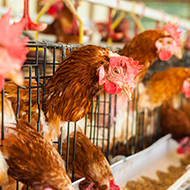London Zoo celebrates birth of endangered froglets
The 33 tadpoles were carried in male frogs' vocal sacs.
Conservationists have called the birth of 33 froglets at London Zoo a ‘milestone’ for the survival of the species.
The birth of the Darwin’s frogs, an endangered species, is a significant part of an international project to save the species from extinction.
Southern Darwin’s frogs (Rhinoderma darwinii) were once thriving in the Parque Tantauco forests of southern Chile. However, in 2023, the arrival of a deadly chytrid fungus resulted in devastation for the species’ numbers.
The fungus caused the frogs to contract amphibian chytridiomycosis. Affecting at least 500 amphibian species, it is the most devastating infectious disease recognised by science.
Since the outbreak began, surveys recorded a 90 per cent decline in monitored populations of Darwin’s frogs.
In October 2024, conservationists launched an urgent, five-day rescue mission for the species. The team travelled over 7000 miles to a remote island off the coast of Chile, where they retrieved healthy frogs for safekeeping at London Zoo.
Throughout the rescue mission, the 33 tadpoles were carried and brooded by 11 male frogs. They were carried in the male frogs’ vocal sacs until they metamorphosed into the 33 froglets that form the next generation of Darwin’s frogs.
The frogs will be provided with refuge at London Zoo while the conservationists work to make the forest habitat safe for them to return to.
The rescue mission has been documented by wildlife filmmaker Paul Glynn, in a video which premieres on YouTube on Monday, 3 February at 6pm. A Leap of Hope follows Mr Glynn as he follows the team through the forests of Tantauco Park to highlight the conservationists’ dedication.
Ben Tapley, curator of amphibians at London Zoo, said: “The successful parent-rearing of these froglets is a powerful symbol of hope for the species, highlights what can be achieved when conservationists work together, and serves as a critical reminder of the role of our conservation zoo.
“We knew we were embarking on something special - the clock was ticking, and we needed to act quickly if we were going to save these frogs – and capturing this work on film has really cemented just how vital our work is.”
Image © ZSL



 An Avian Influenza Prevention Zone (AIPZ) has been introduced across Wales.
An Avian Influenza Prevention Zone (AIPZ) has been introduced across Wales.